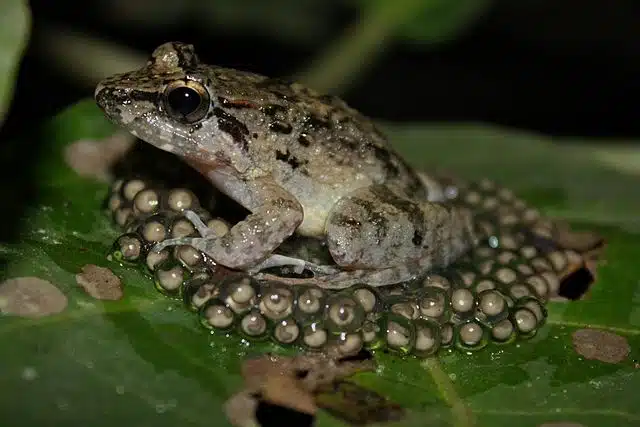The rugged, diverse landscape of Sulawesi, Indonesia, has long fascinated scientists with its unique biodiversity. In a groundbreaking discovery, researchers from the Field Museum in collaboration with the Bogor Zoology Museum unearthed the world’s smallest fanged frog. These species challenge our understanding of amphibian life in the region.
Introducing The World’s Smallest Fanged Frog
This newly discovered species, named Limnonectes phyllofolia, meaning “leaf-nester,” is distinguished not only by its tiny stature but also by its unusual characteristics and behaviors. The frogs are remarkably small, with the largest individuals being about the size of a quarter and weighing as much as a dime, in stark contrast to some of their larger relatives that can weigh up to two pounds.
Unique Reproductive Habits
These fanged frogs exhibit an extraordinary reproductive strategy. Unlike most amphibians that lay their eggs in water, these frogs deposit their eggs on leaves and moss-covered boulders, several feet above the ground. This terrestrial nesting is an adaptation that is rare among frogs and signifies a significant evolutionary divergence.
Fanged Frog Egg Guarding: A Peculiar Behavior
Another intriguing aspect of these fanged frogs is the male egg-guarding behavior. The researchers observed male frogs closely attending to their nests, a responsibility not commonly seen in other frog species. This attentive care includes the application of protective compounds to the eggs, shielding them from dehydration and microbial threats, which is crucial for their survival in a terrestrial environment.
Evolutionary Insights

The discovery of this new species of fanged frog provides valuable insights into evolutionary biology. The species’ smaller fangs, compared to its relatives, may be linked to its unique reproductive strategy. Since these frogs lay their eggs away from the water, they may not need large fangs, which in other species serve to defend prime egg-laying spots along rivers.
Conservation and the Importance of Biodiversity
The existence of this small fanged frog accentuates the critical need for conservation efforts in tropical habitats like Sulawesi. The island’s biodiversity rivals that of global hotspots like the Amazon Rainforest. With habitat destruction posing a constant threat, discovering such unique species highlights the importance of protecting these ecosystems. The frog’s uniqueness, found nowhere else on Earth, underlines the need to preserve the hyper-diversity in these habitats.
Conclusion
The world’s smallest fanged frog in Indonesia is a remarkable testament to the rich, yet often hidden, diversity of life in our planet’s tropical regions. It draws attention to the importance of continued scientific exploration and conservation in these biodiverse areas. The discovery not only enriches our understanding of amphibian biology but also reinforces the need to protect and study the unique ecosystems they inhabit. This finding is a significant contribution to our knowledge of biodiversity and a reminder of the wonders that still await discovery in the world’s most remote and unexplored regions.
Click here for more information on The World’s Smallest “Fanged” Frog.
What do you think about ‘keyword phrase’? Leave a comment below.
Thank you for following along with this article – The World’s Smallest Fanged Frog Discovered.
You may also like:
Join our Forum for free today!

- Shocking Survey Results of only 718 Snow Leopards Identified in India - July 18, 2024
- Do Octopuses Punch Fish For No Reason? - July 5, 2024
- Brave Farm Animals Save Chicken Friend FromHawk - June 30, 2024

